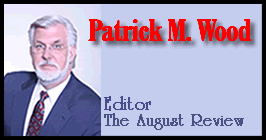TECHNOCRACY AND THE GLOBAL ELITE
By
Patrick Wood
March 10, 2010
NewsWithViews.com
Having studied and written about the global elite for 33 years, and in particular the Trilateral Commission, I still may have been misled by an elaborate system of smoke and mirrors.
1n 1973, when the Trilateral Commission was founded by Zbigniew Brzezinski and David Rockefeller, they claimed as their goal to create a "New International Economic Order."
Through the filter of my economics background, I interpreted this (as did everyone else) to mean some sort of reshuffling of the existing economic system that would benefit the hedonistic interests of the global elite. While the process of globalization has born this out to some extent, there were always unanswered questions.
For instance, why does TC member Al Gore dedicate his life to spreading the false gospel of global warming? Why did the global elite hijack the environmental movement in the 60’s and 70’s in order to preach to us about the need for Sustainable Development and Agenda 21? In fact, why did they create Agenda 21 in the first place? We see what they have done, but figuring out their strategy has been more than elusive and in many cases, it left us grasping at straws.
Well, what if the dynamic duo (Zbig & Dave) really had a NEW economic order in mind? Not like the old one, but a truly new entity? One not based on money, prices, scarcity, or supply and demand but rather on something else?
I
started asking these questions after I rediscovered the Technocracy
movement that had started in 1932 during the depths of the Great Depression.
Technocracy was so thoroughly repudiated by the American political establishment
by the end of the 1930’s that it was even dropped from American
history books.
Yet, Technocracy was a huge movement for a several years, claiming some
500,000 members in California alone. The engineers and scientists who
founded the movement had some very strange ideas (for those days, at
least) about economics, society and the world in general.
They believed that the intermingling of technology with society had created a hybrid social structure. The fact that the global economy was burning at the time proved to them that the old economic structure was doomed to fail because it was not capable of supporting the new social structure. In other words, the two were forever incompatible.
Technocrats thus busied themselves in architecting a new economic system that would replace the old one altogether. They believed that the new economy had to be controlled by an energy-based (not price-based) accounting system where the use of energy would be “in balance” with the existing population. Finite resources and lusty consumption must be carefully controlled so that neither outstrips the other. All participants would receive regular allotments of Energy Certificates that would expire if they were not used up by a certain date. Of course, this new system could only be run by themselves, that is, the scientists, engineers and technicians who understood technology and how to apply it to society.
For a few short years, Technocracy found an academic home at Columbia University, which initially received it with open arms, but later dumped the principal founder, Howard Scott, when the movement became a political hot potato. In the meantime, Columbia helped to sponsor Technocracy’s “Continental Energy Audit” that mapped out an integration strategy, based on energy distribution and consumption, of Canada, the U.S. and Mexico. (Was this the genesis of modern calls for a North American Community as espoused by Dr. Robert Pastor?)
The light bulbs started to flash on for me last year when studying global currencies. The Harvard International Review published “A New Currency” in 2004 that stated: “For those keen to slow global warming, the most effective actions are in the creation of strong national carbon currencies.” HIR concluded that “after seven years of spinning wheels and wrong analogies, the international regime to control carbon is headed, albeit tentatively, down a productive path.” In 2006, UK Environment Secretary David Miliband spoke to the Audit Commission Annual Lecture and flatly stated, "Imagine a country where carbon becomes a new currency.”
The idea for the first paper in my “Technocracy Series” was thus born: “Carbon Currency: A New Beginning for Technocracy?” details the myriad connections between 1930’s Technocracy and today’s calls for Carbon Currency.
In short, a Carbon Currency is designed to manipulate energy distribution and limit its consumption in the industrialized world.
But merely calling for a Carbon Currency means nothing by itself. There would have to be some method of measuring, monitoring and controlling consumption on a global basis.
Thus, my second paper in the series is “Smart Grid: The Implementation of Tecnocracy.” President Obama has seen fit to spend about 1/3 of stimulus money on building the so-called “green” economy.
In particular, money is flowing freely to establish a new “smart” energy grid that will replace every utility meter in the U.S. with digitized units, thus providing 2-way communication between your house and the energy grid masters. And yes, Smart Grid is the exclusive creation of the U.S. government.
Note that funds are not being used to actually upgrade the infrastructure (e.g., new high-voltage transmission systems) but only to implement monitoring and controlling of consumers.
When comparing the original requirements for implementing Technocracy in the 1930’s to the requirements for Smart Grid issued by the Department of Energy, it is no surprise that they matched point for point.
Once in place, Smart Grid will enable the U.S. Department of Energy to set and enforced national policies for both distribution and consumption… even down to the level of directly controlling the power hungry devices in your home, like thermostats, washers, dryers, refrigerators, etc.
Furthermore, I found that Smart Grid is simultaneously being implemented in a host of other countries around the world, from Japan to South Africa to Russia, etc., all paid for by their own economic stimulus packages. The creation of international standards will allow inter-communication between Smart Grid systems in different countries.
There are other complementary government initiatives that make a lot more sense in light of understanding Technocracy.
•
RFID – Radio Frequency Identification chips in
passports, driver licenses, etc.
• NAIS – National Animal
Identification System to track all animals.
• Internet Monitoring - Total
monitoring of the Internet by the NSA and Homeland security.
• Fusion Centers – Created
by Homeland Security, the FBI and NSA to collect “intelligence”
on all Americans at the state level.
• Facial Recognition –
using biometric data to track citizens wherever they appear on a government-placed
surveillance system. Biometric images are created and stored when you
receive a Passport or driver’s license, for instance.
Again,
when I say “government initiative” I mean just that. None
of these had one ounce of private interest before the government decided
to pursue them.
Using stimulus funds in order to create jobs for the “green economy”
may be the ultimate ruse to finally spike the existing economic system
and usher in the “New International Economic Order” that
the Trilateral Commission envisioned in 1973.
| Subscribe to the NewsWithViews Daily News Alerts! |
Two classic works of literature from the 1930’s, both of which had Technocracy in view, should be on your immediate read or re-read list: Brave New World by Aldous Huxley (who called it a scientific dictatorship) and 1984 by George Orwell.











 Share This Article
Share This Article



